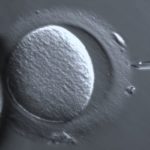1. In this cohort study, among 158,066 individuals, offspring conceived by assisted reproductive technology were found to be shorter, thinner and lighter between infancy and early adolescence compared with naturally conceived offspring.
2. Compared with naturally conceived offspring, smaller offspring size was limited to individuals conceived by fresh but not frozen embryo transfer.
Evidence Rating Level: 2 (Good)
Study Rundown: Assisted reproductive technology (ART) involves the handling of both human oocytes and sperm for the purpose of reproduction. ART procedures mainly include in vitro fertilization and intracytoplasmic sperm injection. ART has resulted in more than 8 million births worldwide, and its use is becoming increasingly prevalent for several reasons including delayed childbearing. The objective of this cohort study was to investigate the association of ART conception with offspring growth and adiposity from infancy to early adulthood. A total of 158,066 offspring, of which 4329 were conceived by ART, were included in each age-group meta-analysis. The main outcomes were height, weight, and body mass index, and secondary outcomes included waist circumference, total body fat percentage, and fat mass index. Offspring who were conceived via ART were found to be shorter, lighter and thinner from infancy up to early adolescence compared with naturally conceived (NC) offspring. The largest differences in height between ART and NC offspring were seen at the youngest ages, however they attenuated by late adolescence. Additionally, smaller size was limited to offspring conceived by fresh but not frozen embryo transfer, compared with naturally conceived offspring. Mean weight was found to be lower in offspring conceived via ART compared with those naturally conceived from between the ages of 3 months up to 10 to 13 years of age. Differences in BMI were also similar to those of mean weight, with mean BMI found to be lower in offspring conceived via ART compared to those naturally conceived until between the ages of 10 to 15 years, with differences most pronounced at younger ages. Given the inclusion of individuals who were exposed to ART decades ago, it is important to note that many of those ART techniques are no longer relevant to contemporary practice. As such, a limitation to this study is that it is difficult to know the extent to which these findings could be generalized to recently born cohorts.
Click to read the study in JAMA Network Open
Relevant Reading: The growth of assisted reproductive treatment-conceived children from birth to 5 years: a national cohort study
In-Depth [prospective cohort]: This study investigated the association of ART conception with offspring growth and adiposity in comparison to naturally conceived offspring from infancy to adolescence. A total of 26 cohorts were included in this study and composed of up to 158,066 individuals born between 1984 to 2018 (between 47.6% to 60.6% females), ranging from Europe (20 cohorts), Australia (2 cohorts), New Zealand (1 cohort), China (1 cohort), Singapore (1 cohort) and Canada (1 cohort). ART conceived offspring were found to be shorter, lighter and thinner from infancy to early adolescence. Adjusted mean differences in offspring weight were -0.27 (95% CI, -0.39 to -0.16) SD units at age younger than 3 months, -0.16 (95% CI, -0.22 to -0.09) SD units at age 17 to 23 months, -0.07 (95% CI, -0.10 to -0.04) SD units at age 6 to 9 years, and -0.02 (95% CI, -0.15 to 0.12) SD units at age 14 to 17 years. Smaller size offspring were more prevalent in individuals conceived by fresh rather than frozen embryo transfer compared with naturally conceived offspring with a difference in weight at age 4 to 5 years of -.014 [95%CI, -0.20 to -0.07] SD units for fresh embryo transfer vs naturally conceived offspring and 0.00 [95% CI, -0.15 to 0.15] SD units for frozen embryo transfer vs naturally conceived offspring. Mean height was found to be smaller in ART conceived offspring compared to naturally conceived offspring in the youngest age groups, although with most older ages, point estimates were close to the null value which was included in the 95% CI. Differences in body fat measurements were observed between the ART vs naturally conceived offspring, and there was imprecise evidence that offspring conceived by ART developed greater adiposity at age older than 17 years (difference in fat mass: 0.23 [95%CI, -0.04 to 0.50] SD units).
Image: PD
©2022 2 Minute Medicine, Inc. All rights reserved. No works may be reproduced without expressed written consent from 2 Minute Medicine, Inc. Inquire about licensing here. No article should be construed as medical advice and is not intended as such by the authors or by 2 Minute Medicine, Inc.


